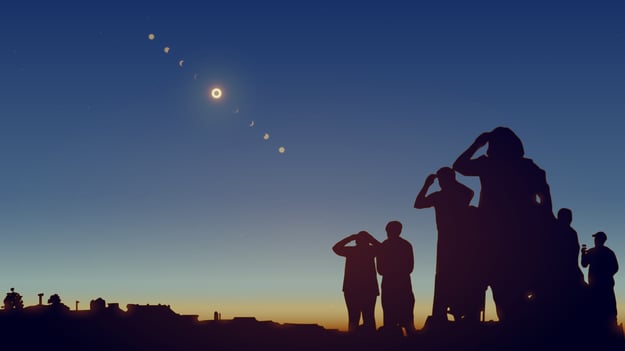Did you enjoy the annular eclipse that passed through Colorado last October? Well if so, you are in luck, because another eclipse is passing through North America on April 8th! The main difference is that this will be a total solar eclipse, which means that for a few brief minutes, if you are in the path of totality, you will be able to take off the eclipse glasses and experience darkness during the daytime.
Unfortunately, unless you are planning on leaving the state of Colorado, you will not be in the path of totality. You will still be able to see a partial solar eclipse with about 60-65% of the sun being blocked out here in the Eagle River Valley. The partial eclipse will last approximately two hours, 25 minutes, begin around 11:30 a.m. and end slightly before 2:00 pm, with the maximum eclipse coverage occuring at 12:40 p.m.
How do we know when exactly the eclipse will happen? Well, astronomers began predicting eclipse timing as early as the 4th century B.C. in China. In some ancient cultures, solar eclipses were seen as bad or a type of supernatural phenomena. Now thanks to our understanding of the science between the Sun’s, Moon’s, and Earth’s orbits, we can predict eclipses with high accuracy hundreds of years into the future.

This will be a good time to watch the eclipse with friends and loved ones because it is the last total eclipse visible in the contiguous U.S until 2044!
A solar eclipse occurs when the Moon passes between Earth and the Sun, which obscures the image of the Sun for someone on Earth. Because the Moon's orbit is tilted at about 5 degrees to Earth's orbit, its shadow usually misses Earth during its New Moon phase. What makes a total solar eclipse special is that the Moon completely blocks out the Sun’s image and all direct sunlight, bringing a dawn or dusk-like darkness to the daytime. This totality only occurs along a narrow path, with a partial solar eclipse visible over the surrounding areas.
All 48 contiguous states will experience at least a partial solar eclipse on April 8th. But what makes this one special is, according to NASA, an estimated 31.6 million people are living in a community that will be within the path of totality. This is compared to the 6.6 million estimated to be in the 2023 annular eclipse path and 12 million in the 2017 total eclipse path. This is also the only total solar eclipse’s path happening in Mexico, Canada and the U.S. in the 21st century!
Eclipses are rare phenomena that remind us how special and magical our existence on Earth can be. So if you are staying here in the valley or traveling somewhere closer to totality, take some time on April 8th to appreciate the eclipse and how special this Sun, Moon and Earth are. Your next chance to experience something like this won’t be for another 20 years!
Safety Disclaimer: Looking directly at the Sun can lead to serious eye damage. To view the eclipse safely, you must wear eclipse glasses or use a pinhole projector. Viewing the Sun through binoculars, a telescope, or camera lens without a solar filter attached can seriously injure your eyes.
Reese Farrow is the Lead Naturalist at Walking Mountains and he will be fortunate enough to be able to travel in the path of totality!







